Spatiotemporal Patterns of Heavy-Metal Pollution in Coastal Pinqing Lagoon (Southern China): Anthropogenic and Hydrological Effect
Abstract
:1. Introduction
2. Materials and Methods
2.1. Regional Setting of the Study Area
2.2. Field Sampling, Sedimentary Proxy Analysis, and Secondary Data Collection
2.3. Heavy-Metal Pollution Assessment
2.3.1. Enrichment Factor
2.3.2. Degree of Contamination (CD) and Potential Ecological Risk Index (RI)
2.4. Statistical Analysis Method
3. Results
3.1. Spatial and Temporal Variations in Heavy Metals in Sediments
3.1.1. Spatial Distribution of Heavy Metals in Sediments
3.1.2. Vertical Variations in Heavy-Metal Content in Sediment
3.2. Possible Sources of Heavy Metals
3.3. Heavy-Metal Pollution Assessment
4. Discussion
4.1. Stage Division, History of Human Activity, and Lagoon Pollution

4.2. Spatial Differences in Heavy-Metal Pollution in the Lagoon and Adjacent Water Bodies
4.3. Source Identification and Drivers of Environmental Changes in Lagoon
4.4. Insights into the Management of Heavy-Metal Pollution in Coastal Lagoons
5. Conclusions
Author Contributions
Funding
Data Availability Statement
Acknowledgments
Conflicts of Interest
References
- Pérez-Ruzafa, A.; Pérez-Ruzafa, I.M.; Newton, A.; Marcos, C. Chapter 15—Coastal Lagoons: Environmental Variability, Ecosystem Complexity, and Goods and Services Uniformity. In Coasts and Estuaries; Wolanski, E., Day, J.W., Elliott, M., Ramachandran, R., Eds.; Elsevier: Amsterdam, The Netherlands, 2019; pp. 253–276. [Google Scholar]
- Temmerman, S.; Meire, P.; Bouma, T.J.; Herman, P.M.J.; Ysebaert, T.; De Vriend, H.J. Ecosystem-based coastal defence in the face of global change. Nature 2013, 504, 79–83. [Google Scholar] [CrossRef] [PubMed]
- Sun, W.; Zhang, J.; Ma, Y.; Xia, D. Investigation of the evolution of China coastal lagoons from 1979 to 2010 using multi-temporal satellite data. Acta Oceanol. Sin. 2015, 37, 54–69, (In Chinese with English Abstract). [Google Scholar]
- Jiang, R.; Lin, C.; Zhou, K.; Liu, Y.; Chen, J.; Wang, S.; Pan, Z.; Sun, X.; Wang, W.; Lin, H. Pollution, ecological risk, and source identification of potentially toxic elements in sediments of a landscape urban lagoon, China. Mar. Pollut. Bull. 2022, 174, 113192. [Google Scholar] [CrossRef] [PubMed]
- Peter, P.O.; Rashid, A.; Nkinahamira, F.; Wang, H.; Sun, Q.; Gad, M.; Yu, C.-P.; Hu, A. Integrated assessment of major and trace elements in surface and core sediments from an urban lagoon, China: Potential ecological risks and influencing factors. Mar. Pollut. Bull. 2021, 170, 112651. [Google Scholar] [CrossRef] [PubMed]
- Ge, C.; Wang, L.; Zhang, Y.; Qu, C.; Liu, X.; Zhu, L.; Song, J.; Zheng, F.; Li, L.; Liu, W.; et al. Responses of the macrobenthic community to cage culture in one tropical lagoon in the South China Sea. Ecol. Indic. 2022, 140, 108985. [Google Scholar] [CrossRef]
- Shen, J. Progress and prospect of palaeolimnology research in China. J. Lake Sci. 2009, 21, 307–313, (In Chinese with English Abstract). [Google Scholar] [CrossRef]
- Li, C.; Wang, H.; Liao, X.; Xiao, R.; Liu, K.; Bai, J.; Li, B.; He, Q. Heavy metal pollution in coastal wetlands: A systematic review of studies globally over the past three decades. J. Hazard. Mater. 2022, 424, 127312. [Google Scholar] [CrossRef] [PubMed]
- Garcés-Ordóñez, O.; Saldarriaga-Vélez, J.F.; Espinosa-Díaz, L.F.; Canals, M.; Sánchez-Vidal, A.; Thiel, M. A systematic review on microplastic pollution in water, sediments, and organisms from 50 coastal lagoons across the globe. Environ. Pollut. 2022, 315, 120366. [Google Scholar] [CrossRef] [PubMed]
- Maanan, M.; Saddik, M.; Maanan, M.; Chaibi, M.; Assobhei, O.; Zourarah, B. Environmental and ecological risk assessment of heavy metals in sediments of Nador lagoon, Morocco. Ecol. Indic. 2015, 48, 616–626. [Google Scholar] [CrossRef]
- Shetaia, S.A.; Khatita, A.M.A.; Abdelhafez, N.A.; Shaker, I.M.; El Kafrawy, S.B. Human-induced sediment degradation of Burullus lagoon, Nile Delta, Egypt: Heavy metals pollution status and potential ecological risk. Mar. Pollut. Bull. 2022, 178, 113566. [Google Scholar] [CrossRef] [PubMed]
- Mendoza-Carranza, M.; Sepúlveda-Lozada, A.; Dias-Ferreira, C.; Geissen, V. Distribution and bioconcentration of heavy metals in a tropical aquatic food web: A case study of a tropical estuarine lagoon in SE Mexico. Environ. Pollut. 2016, 210, 155–165. [Google Scholar] [CrossRef] [PubMed]
- Green-Ruiz, C.; Páez-Osuna, F. Heavy metal anomalies in lagoon sediments related to intensive agriculture in Altata-Ensenada del Pabellón coastal system (SE Gulf of California). Environ. Int. 2001, 26, 265–273. [Google Scholar] [CrossRef] [PubMed]
- Yao, S. The water environment of the Pinqing Lagoon in Eastern Guangdong, China. In Proceedings of the 2010 International Conference on Mechanic Automation and Control Engineering, Wuhan, China, 26–28 June 2010; pp. 4798–4801. [Google Scholar]
- Cai, Y.; Li, F.; Liu, L.; Lu, W.; Cao, B. Residue characteristics and ecological risk assessment of organochlorine pesticides in coastal waters and sediments of Shanwei. Mar. Environ. Sci. 2022, 41, 387–394, (In Chinese with English Abstract). [Google Scholar] [CrossRef]
- Wang, Y.; Huang, J. A preliminary study on the occurrence pattern of red tide of marine resources. Resour. Econ. Environ. Prot. 2014, 2, 157–159, (In Chinese with English Abstract). [Google Scholar] [CrossRef]
- Meng, Y.; Yin, X.; Feng, J. Acid volatile sulfides and biotoxicity of heavy metals in sediments from the Pinqing Lagoon. Adv. Mar. Sci. 2012, 30, 119–124, (In Chinese with English Abstract). [Google Scholar]
- Li, Z. Evalution of heavy metal pollution for surface sediments near Shanwei Port. Mar. Geol. Lett. 2010, 26, 10–15, (In Chinese with English Abstract). [Google Scholar] [CrossRef]
- Yao, S. The Modern Sedimentary and Hydraulic Environment and Environmental Geochemistry of Heavy Metals in Pinging Lagoon, East of GuangDong Province. Ph.D. Thesis, The Graduate School of the Chinese Academy of Sciences, Beijing, China, 2010. (In Chinese with English Abstract). [Google Scholar]
- Xian, H.; Dong, X.; Wang, Y.; Li, Y.; Xing, J.; Jeppesen, E. Geochemical baseline establishment and pollution assessment of heavy metals in the largest coastal lagoon (Pinqing Lagoon) in China mainland. Mar. Pollut. Bull. 2022, 177, 113459. [Google Scholar] [CrossRef]
- Sun, Q.; Zhang, C.; Wu, L.; Ju, M.; Lei, C. Concentration distribution and pollution assessment of heavy metals in surface sediments in Honghai Bay. Ecol. Environ. Sci. 2017, 26, 843–849, (In Chinese with English Abstract). [Google Scholar] [CrossRef]
- Heim, S.; Schwarzbauer, J. Pollution history revealed by sedimentary records: A review. Environ. Chem. Lett. 2013, 11, 255–270. [Google Scholar] [CrossRef]
- Zhou, Y.; Wang, L.; Xiao, T.; Chen, Y.; Beiyuan, J.; She, J.; Zhou, Y.; Yin, M.; Liu, J.; Liu, Y.; et al. Legacy of multiple heavy metal(loid)s contamination and ecological risks in farmland soils from a historical artisanal zinc smelting area. Sci. Total Environ. 2020, 720, 137541. [Google Scholar] [CrossRef]
- Sun, Z.; Yao, S.; Chen, Z.; Chen, J.; Sun, L. Analysis of the sediment environmental characteristics of Pinqing Lake in Shanwei, Guangdong Province. J. Trop. Oceanogr. 2010, 29, 65–71, (In Chinese with English Abstract). [Google Scholar]
- Gong, P.; Liu, H.; Zhang, M.; Li, C.; Wang, J.; Huang, H.; Clinton, N.; Ji, L.; Li, W.; Bai, Y.; et al. Stable classification with limited sample: Transferring a 30-m resolution sample set collected in 2015 to mapping 10-m resolution global land cover in 2017. Sci. Bull. 2019, 64, 370–373. [Google Scholar] [CrossRef] [PubMed]
- SCLRCC (Shanwei City Local Record Compilation Committee). Local Records of Shanwei City; Fangzhi Publishing House: Beijing, China, 2013. (In Chinese) [Google Scholar]
- HCLCCC (Haifeng County Local Chorography Compilation Committee). Local Records of Haifeng County; Guangdong People’s Publishing House: Guangzhou, China, 2005. (In Chinese) [Google Scholar]
- Shanwei City Bureau of Statistics. Statistical Yearbook of Shanwei; Official Website of Shanwei Municipal Bureau of Statistics: Shanwei, China, 2017. [Google Scholar]
- Xian, H.; Dong, X.; Li, Y.; Zhan, N.; Jeppesen, E. High-resolution reconstruction of typhoon events since ~1850 CE based on multi-proxy sediment records in a coastal lagoon, South China. Sci. Total Environ. 2022, 803, 150063. [Google Scholar] [CrossRef] [PubMed]
- Thompson, R.P.; Simson, J.A.V.; Currie, M.G. Atriopeptin distribution in the developing rat heart. Anat. Embryol. 1986, 175, 227–233. [Google Scholar] [CrossRef] [PubMed]
- Mariyanto, M.; Amir, M.F.; Utama, W.; Hamdan, A.M.; Bijaksana, S.; Pratama, A.; Yunginger, R.; Sudarningsih, S. Heavy metal contents and magnetic properties of surface sediments in volcanic and tropical environment from Brantas River, Jawa Timur Province, Indonesia. Sci. Total Environ. 2019, 675, 632–641. [Google Scholar] [CrossRef]
- Szczepaniak-Wnuk, I.; Górka-Kostrubiec, B.; Dytłow, S.; Szwarczewski, P.; Kwapuliński, P.; Karasiński, J. Assessment of heavy metal pollution in Vistula river (Poland) sediments by using magnetic methods. Environ. Sci. Pollut. Res. 2020, 27, 24129–24144. [Google Scholar] [CrossRef] [PubMed]
- Horng, C.-S.; Huh, C.-A.; Chen, K.-H.; Huang, P.-R.; Hsiung, K.-H.; Lin, H.-L. Air pollution history elucidated from anthropogenic spherules and their magnetic signatures in marine sediments offshore of Southwestern Taiwan. J. Mar. Syst. 2009, 76, 468–478. [Google Scholar] [CrossRef]
- GB 17378.5-2007; GAQSIQ (General Administration of Ouality Supervision, Inspection and Ouarantine of the People’s Republic of China); SAPRC (Standardization Administration of the People’s Republic of China). The Specification for Marine Monitoring. China Standard Publishing House: Beijing, China, 2007; p. 104.
- Gu, Y. Distributions of Biogenic Elements, Heavy Metals and Potential Ecological Risk Assessment of Heavy Metal in Surface Sediments from Coastal Sea of Guandong Province. Master’s Thesis, Jinan University, Jinan, China, 2009. (In Chinese with English Abstract). [Google Scholar]
- Zhang, H.; Gu, J.; Hu, R.; Lin, G.; Wang, Z. Characteristics of heavy metals pollution in sediments of four reservoirs from the east coast of Guangdong Province, South China. Chin. J. Ecol. 2012, 31, 1807–1816, (In Chinese with English Abstract). [Google Scholar]
- Buat-Menard, P.; Chesselet, R. Variable influence of the atmospheric flux on the trace metal chemistry of oceanic suspended matter. Earth Planet. Sci. Lett. 1979, 42, 399–411. [Google Scholar] [CrossRef]
- Islam, M.S.; Ahmed, M.K.; Raknuzzaman, M.; Habibullah-Al-Mamun, M.; Islam, M.K. Heavy metal pollution in surface water and sediment: A preliminary assessment of an urban river in a developing country. Ecol. Indic. 2015, 48, 282–291. [Google Scholar] [CrossRef]
- Hans Wedepohl, K. The composition of the continental crust. Geochim. Cosmochim. Acta 1995, 59, 1217–1232. [Google Scholar] [CrossRef]
- Apitz, S.E.; Degetto, S.; Cantaluppi, C. The use of statistical methods to separate natural background and anthropogenic concentrations of trace elements in radio-chronologically selected surface sediments of the Venice Lagoon. Mar. Pollut. Bull. 2009, 58, 402–414. [Google Scholar] [CrossRef]
- Hakanson, L. An ecological risk index for aquatic pollution control.a sedimentological approach. Water Res. 1980, 14, 975–1001. [Google Scholar] [CrossRef]
- Jiang, S.; Bralower, T.J.; Patzkowsky, M.E.; Kump, L.R.; Schueth, J.D. Geographic controls on nannoplankton extinction across the Cretaceous/Palaeogene boundary. Nat. Geosci. 2010, 3, 280–285. [Google Scholar] [CrossRef]
- Kruskal, J.B. Multidimensional scaling by optimizing goodness of fit to a nonmetric hypothesis. Psychometrika 1964, 29, 1–27. [Google Scholar] [CrossRef]
- Lai, J. Canoco 5: A new version of an ecological multivariate data ordination program. Biodivers. Sci. 2013, 21, 765. [Google Scholar]
- Mikac, N.; Sondi, I.; Vdović, N.; Pikelj, K.; Ivanić, M.; Lučić, M.; Bačić, N.; Turk, M.F.; Škapin, D.S.; Krivokapić, S. Origin and history of trace elements accumulation in recent Mediterranean sediments under heavy human impact. A case study of the Boka Kotorska Bay (Southeast Adriatic Sea). Mar. Pollut. Bull. 2022, 179, 113702. [Google Scholar] [CrossRef] [PubMed]
- Koschinsky, A.; Hein, J.R. Uptake of elements from seawater by ferromanganese crusts: Solid-phase associations and seawater speciation. Mar. Geol. 2003, 198, 331–351. [Google Scholar] [CrossRef]
- Kubier, A.; Wilkin, R.T.; Pichler, T. Cadmium in soils and groundwater: A review. Appl. Geochem. 2019, 108, 104388. [Google Scholar] [CrossRef]
- Cetin, M.; Aljama, A.M.O.; Alrabiti, O.B.M.; Adiguzel, F.; Sevik, H.; Zeren Cetin, I. Determination and mapping of regional change of Pb and Cr pollution in Ankara city center. Water Air Soil Pollut. 2022, 233, 163. [Google Scholar] [CrossRef]
- Khan, M.N.; Mohammad, F. Eutrophication: Challenges and solutions. In Eutrophication: Causes, Consequences and Control: Volume 2; Springer: Dordrecht, The Netherlands, 2014; pp. 1–15. [Google Scholar]
- Thornton, I. Sources and pathways of arsenic in the geochemical environment: Health implications. Geol. Soc. Lond. Spec. Publ. 1996, 113, 153–161. [Google Scholar] [CrossRef]
- Smedley, P.L.; Kinniburgh, D.G. A review of the source, behaviour and distribution of arsenic in natural waters. Appl. Geochem. 2002, 17, 517–568. [Google Scholar] [CrossRef]
- Hassan, A.S. Inorganic-based pesticides: A review article. Egypt. Sci. J. Pestic. 2019, 5, 39–52. [Google Scholar]
- Zhang, L.; Lu, J. Redox Transformation of Arsenic and Antimony in Soils Mediated by Pantoea sp. IMH. Environ. Sci. Technol. 2017, 38, 3937–3943, (In Chinese with English Abstract). [Google Scholar] [CrossRef]
- Wang, X.; Lang, C.; Fang, C.; Wang, J.; Wu, X.; Zhou, L. Distribution of Species of Arsenic and Antimony in Surface Sediments of Ledong Sea Area in South China Sea. Contemp. Chem. Ind. 2015, 44, 1821–1824, (In Chinese with English Abstract). [Google Scholar] [CrossRef]
- Xia, W.; Qu, X.; Zhang, Y.; Wang, R.; Xin, M.; Guo, C.; Chen, Y. Effects of different fish farming methods on heavy metals in water and sediments of typical lakes in the middle reaches of the Yangtze River. In Proceedings of the 2016 Academic Annual Meeting of the Chinese Fisheries Society, Chengdu, China, 21–23 November 2016; p. 143, (In Chinese with English Abstract). [Google Scholar]
- Gaim, K.; Gebru, G.; Abba, S. The effect of arsenic on liver tissue of experimental animals (fishes and mice)—A review article. Int. J. Sci. Res. Publ. 2015, 5, 161–169. [Google Scholar]
- Zhang, X.; Liu, L.; Chen, X.; Gao, Y.; Xie, S.; Mi, J. GLC_FCS30: Global land-cover product with fine classification system at 30 m using time-series Landsat imagery. Earth Syst. Sci. Data 2021, 13, 2753–2776. [Google Scholar] [CrossRef]
- Cheng, S. Heavy metal pollution in China: Origin, pattern and control. Environ. Sci. Pollut. Res. 2003, 10, 192–198. [Google Scholar] [CrossRef]
- McVey, I.; Michalek, A.; Mahoney, T.; Husic, A. Urbanization as a limiter and catalyst of watershed-scale sediment transport: Insights from probabilistic connectivity modeling. Sci. Total Environ. 2023, 894, 165093. [Google Scholar] [CrossRef]
- Xiao, X.; Tong, Y.; Wang, D.; Gong, Y.; Zhou, Z.; Liu, Y.; Huang, H.; Zhang, B.; Li, H.; You, J. Spatial distribution of benthic toxicity and sediment-bound metals and arsenic in Guangzhou urban waterways: Influence of land use. J. Hazard. Mater. 2022, 439, 129634. [Google Scholar] [CrossRef]
- Wang, X.-N.; Gu, Y.-G.; Wang, Z.-H.; Ke, C.-L.; Mo, M.-S. Biological risk assessment of heavy metals in sediments and health risk assessment in bivalve mollusks from Kaozhouyang Bay, South China. Mar. Pollut. Bull. 2018, 133, 312–319. [Google Scholar] [CrossRef]
- Cho, J.; Hyun, S.; Han, J.H.; Kim, S.; Shin, D.-H. Historical trend in heavy metal pollution in core sediments from the Masan Bay, Korea. Mar. Pollut. Bull. 2015, 95, 427–432. [Google Scholar] [CrossRef] [PubMed]
- Duan, J.; Tan, J. Atmospheric heavy metals and Arsenic in China: Situation, sources and control policies. Atmos. Environ. 2013, 74, 93–101. [Google Scholar] [CrossRef]
- Li, Y.; Liao, Y.; Dong, X.; Xian, H.; Kattel, G. Hydrological disconnection from the Yangtze River triggered rapid environmental degradation in a riverine lake. Limnologica 2022, 95, 125993. [Google Scholar] [CrossRef]
- Dou, Y.; Yu, X.; Liu, L.; Ning, Y.; Bi, X.; Liu, J. Effects of hydrological connectivity project on heavy metals in Wuhan urban lakes on the time scale. Sci. Total Environ. 2022, 853, 158654. [Google Scholar] [CrossRef] [PubMed]
- Huang, S.; Zhang, K.; Lin, Q.; Liu, J.; Shen, J. Abrupt ecological shifts of lakes during the Anthropocene. Earth-Sci. Rev. 2022, 227, 103981. [Google Scholar] [CrossRef]
- Will, S.; Paul, J.C.; John, R.M. The Anthropocene: Are Humans Now Overwhelming the Great Forces of Nature. AMBIO A J. Hum. Environ. 2007, 36, 614–621. [Google Scholar] [CrossRef]
- Castañeda, O.; Contreras, F. La biodiversidad de las lagunas costeras. Ciencias 2004, 076, 46–56. [Google Scholar]
- Zhou, J.; Leavitt, P.R.; Zhang, Y.; Qin, B. Anthropogenic eutrophication of shallow lakes: Is it occasional? Water Res. 2022, 221, 118728. [Google Scholar] [CrossRef]
- Bosch, A.C.; O’Neill, B.; Sigge, G.O.; Kerwath, S.E.; Hoffman, L.C. Heavy metals in marine fish meat and consumer health: A review. J. Sci. Food Agric. 2016, 96, 32–48. [Google Scholar] [CrossRef]
- Gray, J.S. Biomagnification in marine systems: The perspective of an ecologist. Mar. Pollut. Bull. 2002, 45, 46–52. [Google Scholar] [CrossRef] [PubMed]
- Davies-Vollum, K.S.; Zhang, Z.; Agyekumhene, A. Impacts of lagoon opening and implications for coastal management: Case study from Muni-Pomadze lagoon, Ghana. J. Coast. Conserv. 2019, 23, 293–301. [Google Scholar] [CrossRef]
- Chen, S.; WU, Z.; Cai, Z.; Xiang, Y.; Xing, K.; Wang, R.; Lin, G.; Tong, Y. Distribution characteristics and pollution evaluation of heavy metals in the surface sediments of Li’an lagoon, Hainan province. Mar. Sci. 2018, 42, 124–133. [Google Scholar]
- El-Kafrawy, S.; Ahmed, H. Using Remote Sensing technology integrated with the Geographic Information System (GIS) to develop a Plan to save the Egyptian Northern lakes Case study: Lake Burullus. Aquat. Sci. Fish Resour. (ASFR) 2022, 3, 66–73. [Google Scholar] [CrossRef]
- Whitehead, N.; Oregioni, B.; Fukai, R. Background Levels of Trace Metals in Mediterranean Sediments. Rapp. Procès Verbaux Réunions-Comm. Int. Pour L’exploration Sci. Méditerranée 1985, 29, 233–240. [Google Scholar]
- He, Y.; Wen, W. Distribution and concentrations of some heavy metals in the offshore bottom sediments, Guangdong Province. Trop. Ocean. 1982, 1, 58–71, (In Chinese with English Abstract). [Google Scholar]
- Zhang, Y.; Du, J. Background values of pollutants in sediments of the South China Sea. Acta Ocean. 2005, 27, 161–166, (In Chinese with English Abstract). [Google Scholar]
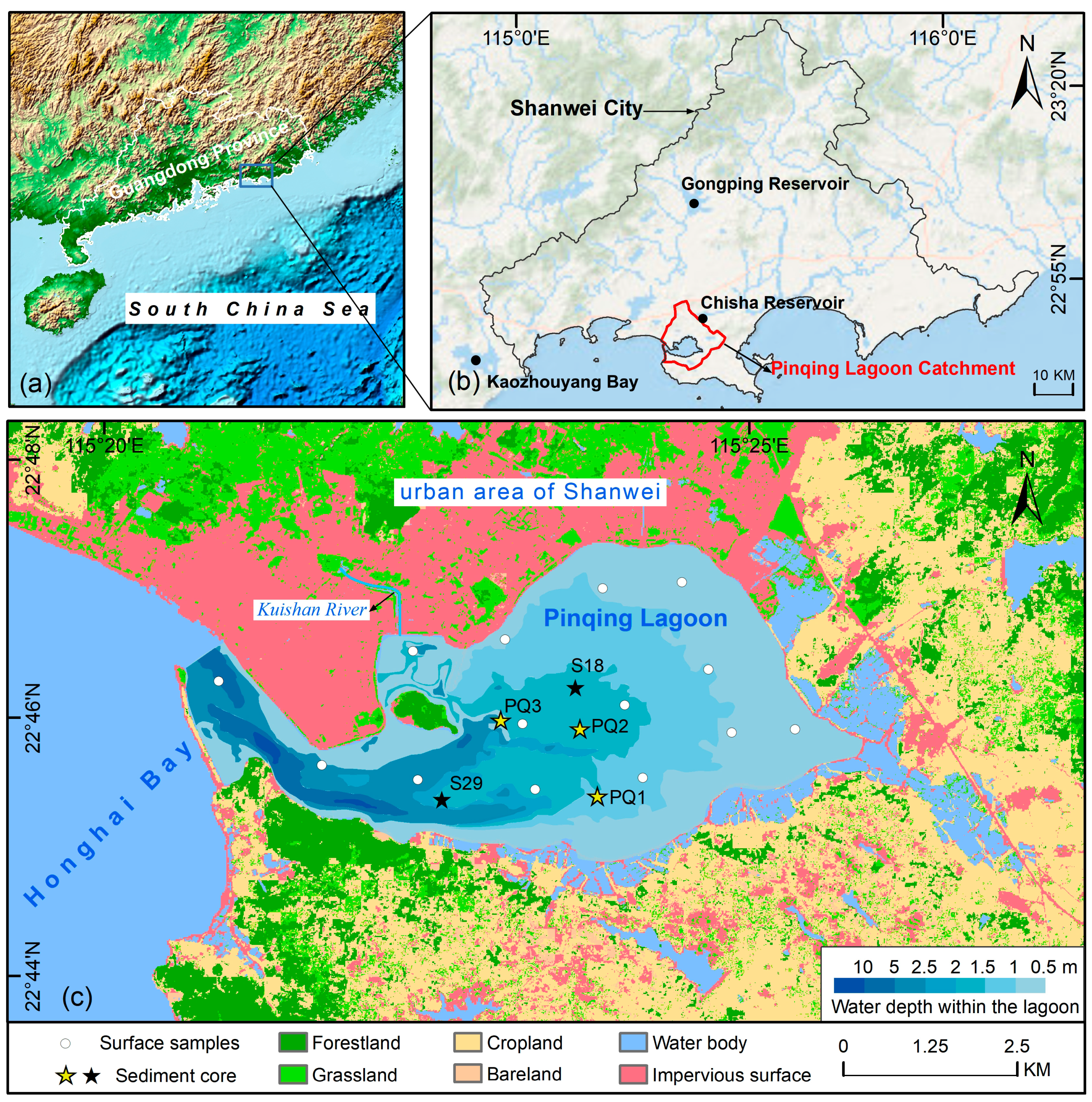
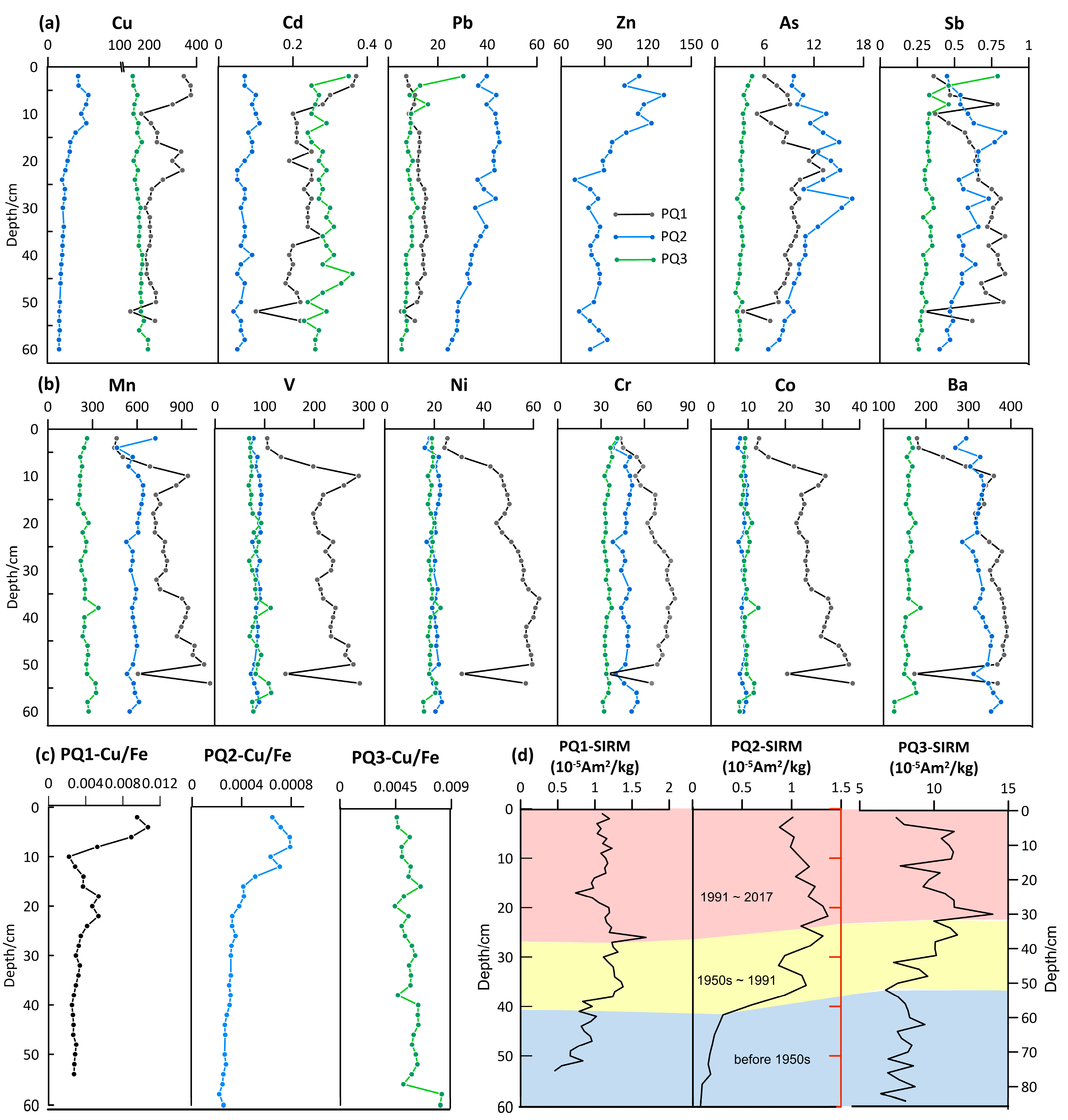
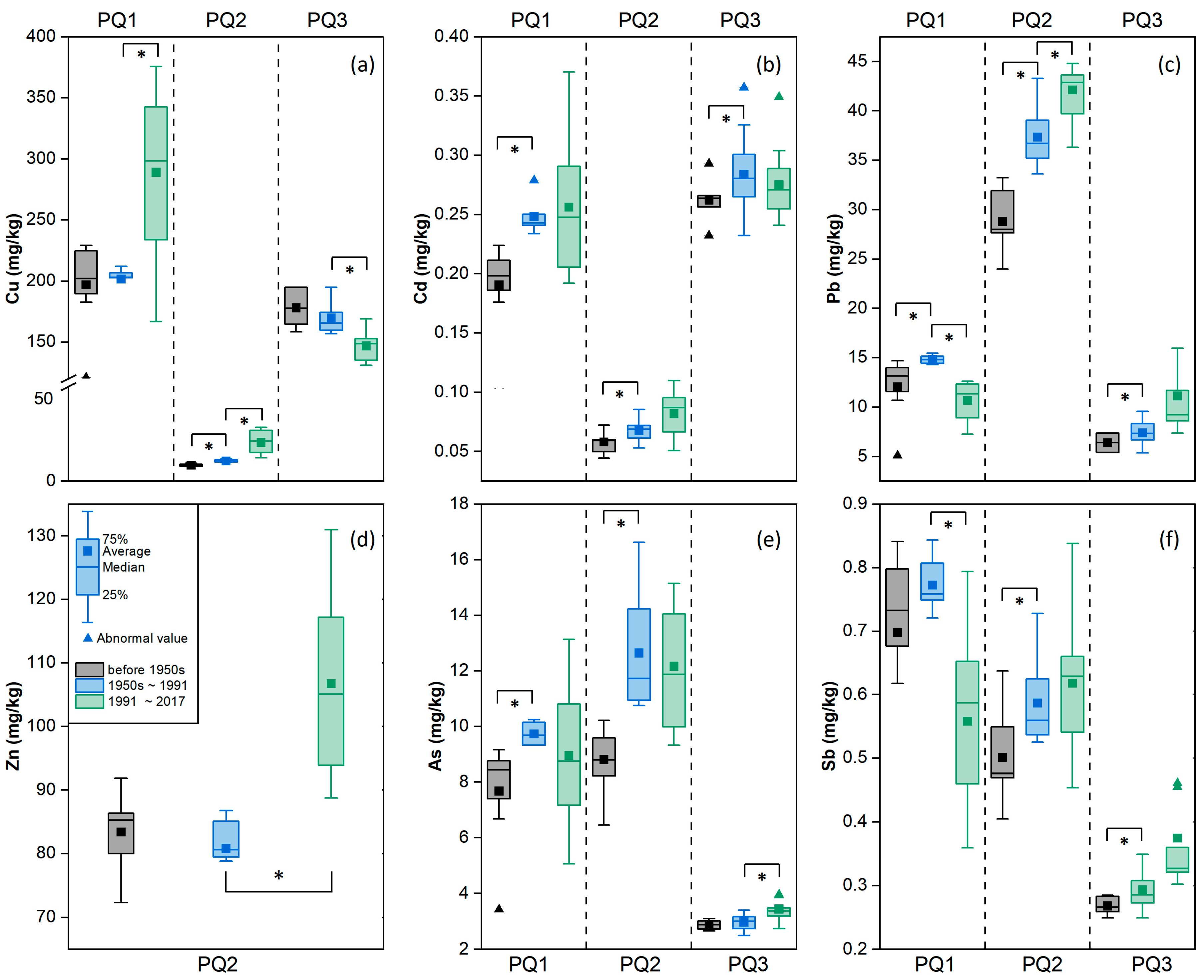
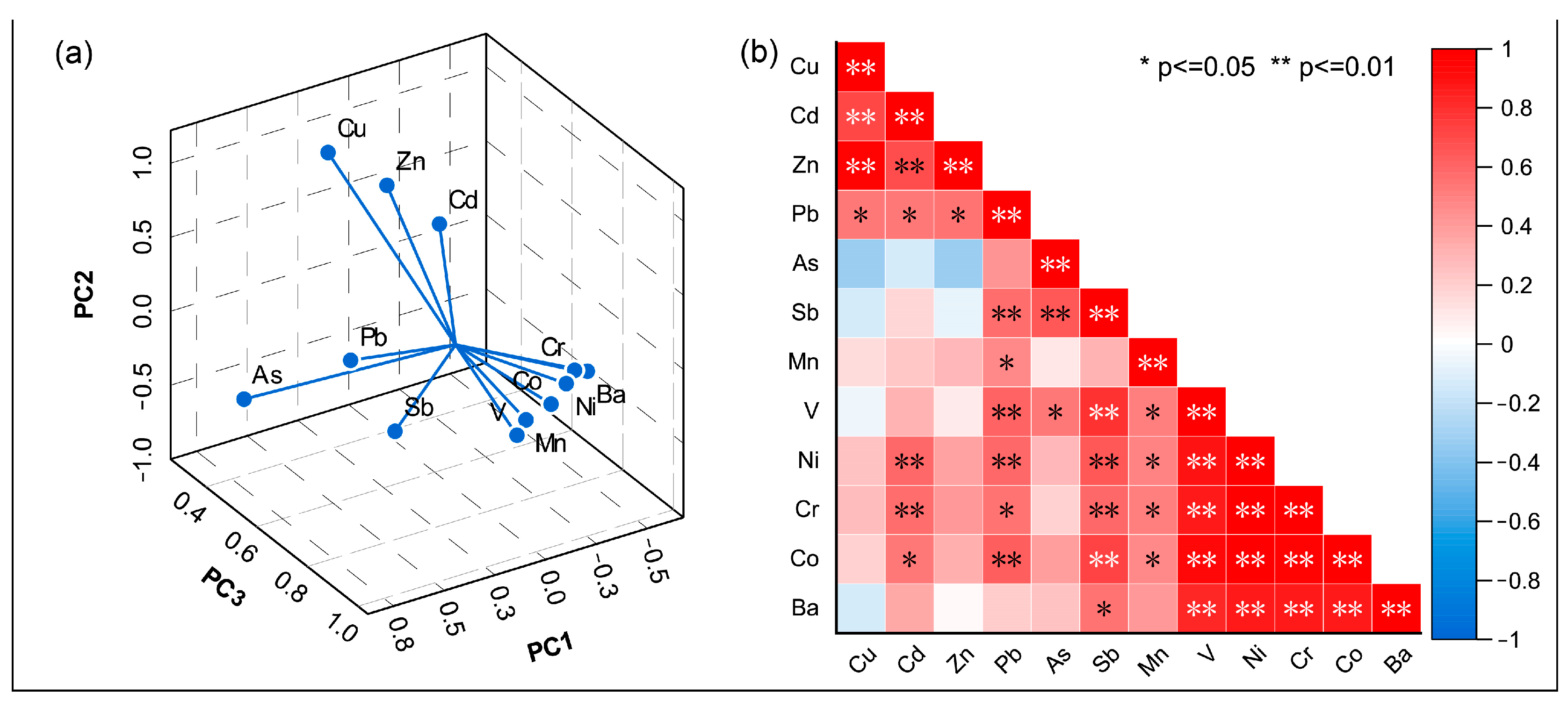

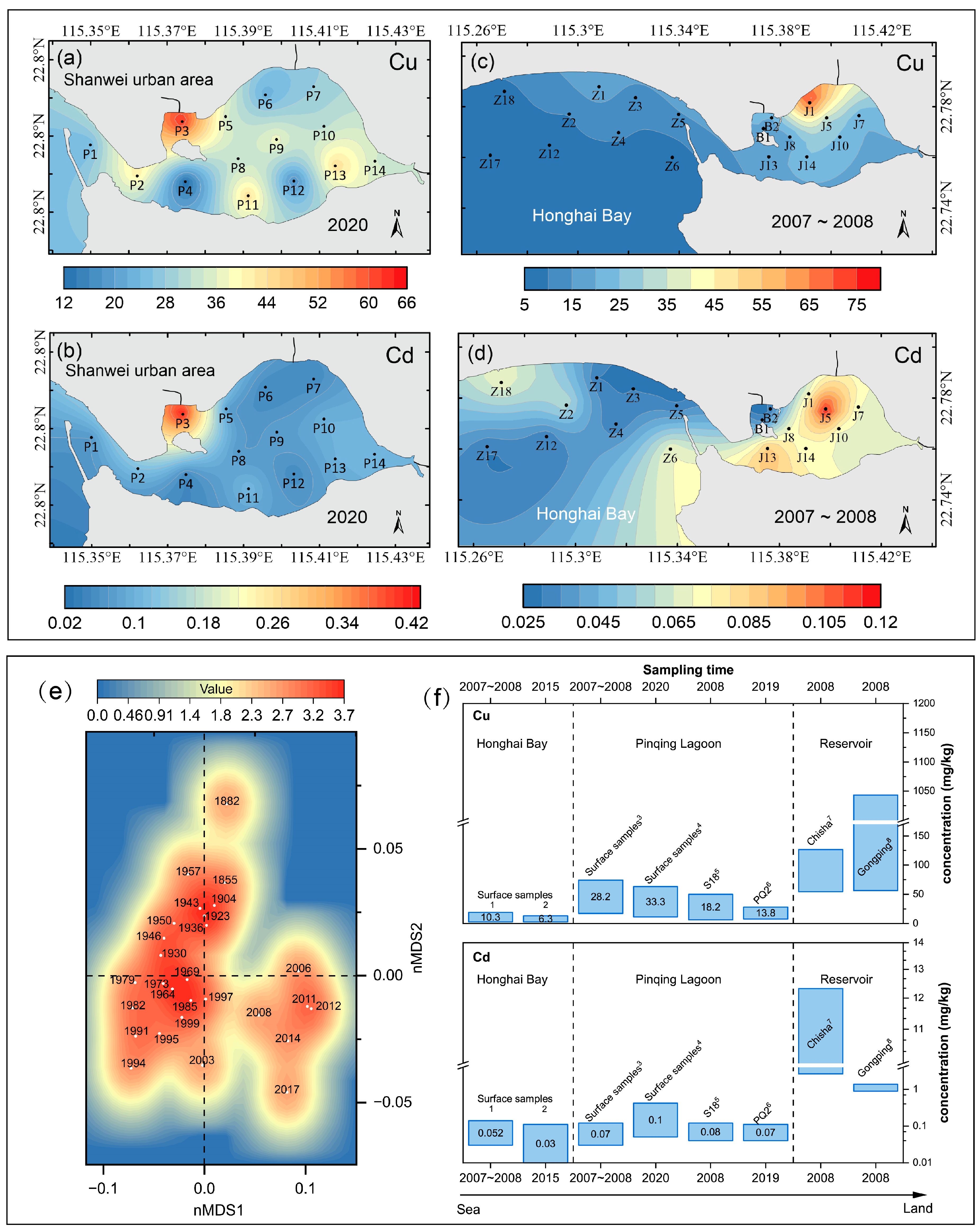
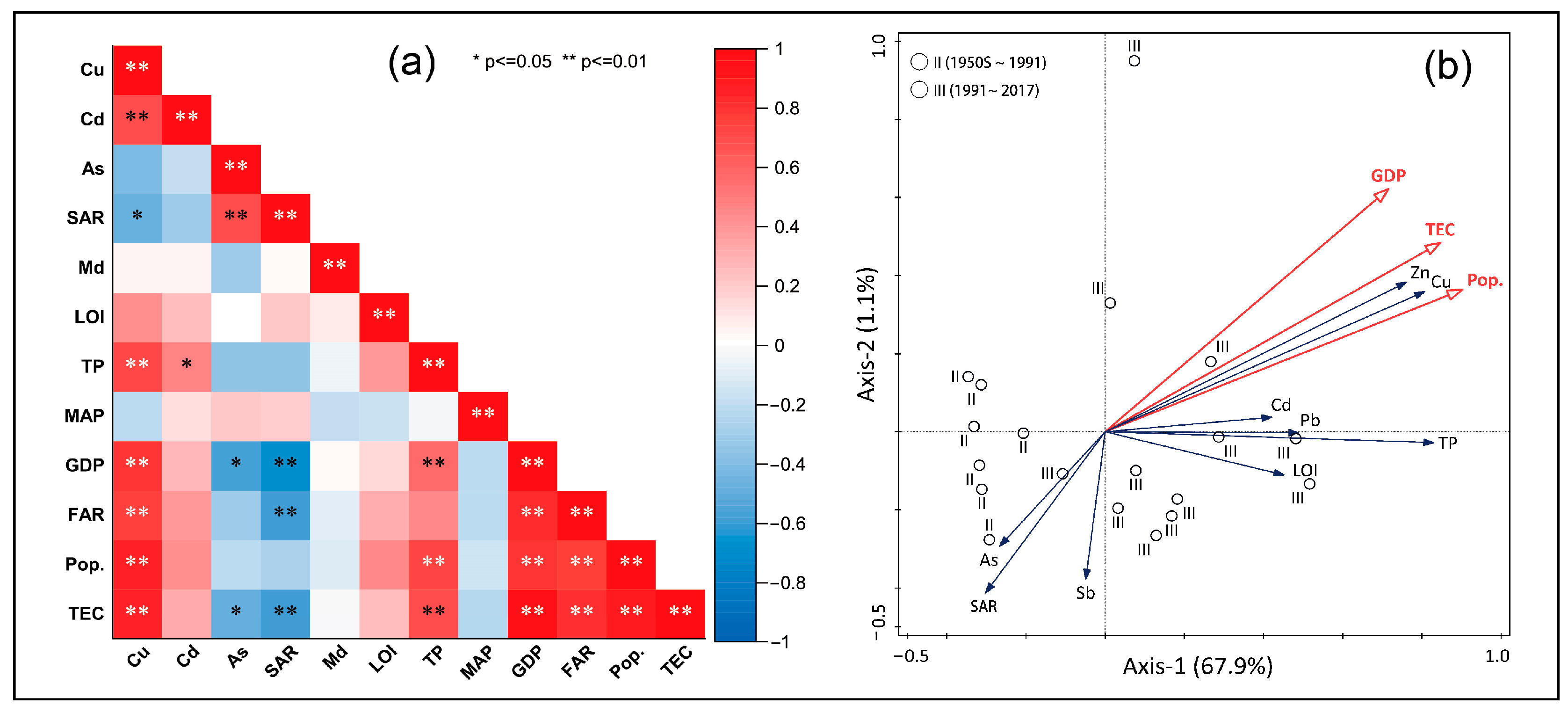
| Item | Fe | Cu | Cd | Zn | Pb | As | Sb | Mn | V | Ni | Cr | Co | Ba |
|---|---|---|---|---|---|---|---|---|---|---|---|---|---|
| Background 1 | 32,700 | 8.1 | 0.058 | 82.0 | 27 | 8.2 | 0.46 | ||||||
| Toxic coefficient 2 | 5 | 30 | 1 | 5 | 10 | 7 | |||||||
| PQ1 | |||||||||||||
| Maximum | 81,894 | 376 | 0.4 | 15.5 | 13.1 | 0.84 | 1091 | 292 | 62.3 | 81.1 | 38.1 | 391 | |
| Minimum | 35,037 | 121 | 0.1 | 5.1 | 3.4 | 0.29 | 446 | 105 | 24.1 | 33.90 | 12.13 | 173 | |
| Mean | 63,927 | 238.9 | 0.23 | 12.06 | 8.7 | 0.65 | 793.6 | 218.3 | 50.0 | 66.2 | 26.7 | 333.3 | |
| C.V. | 0.20 | 0.28 | 0.22 | 0.22 | 0.24 | 0.25 | 0.21 | 0.23 | 0.22 | 0.18 | 0.25 | 0.20 | |
| PQ2 | |||||||||||||
| Maximum | 38,083 | 28.40 | 0.11 | 131.0 | 44.8 | 16.6 | 0.8 | 723 | 93.3 | 23.0 | 55.2 | 9.6 | 377 |
| Minimum | 29,290 | 7.74 | 0.04 | 69.4 | 24.0 | 6.5 | 0.4 | 464 | 70.6 | 16.1 | 38.0 | 7.2 | 269 |
| Mean | 34,230 | 13.77 | 0.07 | 91.83 | 36.48 | 11.22 | 0.57 | 585.3 | 84.53 | 20.38 | 47.12 | 8.78 | 327.5 |
| C.V. | 0.07 | 0.47 | 0.29 | 0.17 | 0.17 | 0.22 | 0.18 | 0.08 | 0.07 | 0.08 | 0.09 | 0.07 | 0.07 |
| PQ3 | |||||||||||||
| Maximum | 33,495 | 195 | 0.36 | 30.29 | 4.54 | 0.79 | 339 | 112.9 | 22.5 | 41.2 | 12.7 | 187 | |
| Minimum | 25,947 | 131 | 0.23 | 5.39 | 2.50 | 0.25 | 203 | 68.1 | 15.6 | 31.2 | 7.6 | 125 | |
| Mean | 27,722 | 157.7 | 0.28 | 9.34 | 3.23 | 0.34 | 252.0 | 81.19 | 18.64 | 34.24 | 9.42 | 158.3 | |
| C.V. | 0.07 | 0.10 | 0.11 | 0.48 | 0.13 | 0.29 | 0.13 | 0.15 | 0.07 | 0.06 | 0.12 | 0.08 | |
| S18 3 | |||||||||||||
| Maximum | 50.3 | 0.25 | 128 | 79.5 | 16.23 | ||||||||
| Minimum | 6.6 | 0.04 | 47.2 | 19.7 | 5.82 | ||||||||
| Mean | 54.95 | 0.08 | 91.72 | 44.55 | 11.43 | ||||||||
| C.V. | 0.48 | 0.38 | 0.17 | 0.26 | 0.25 | ||||||||
| S29 3 | |||||||||||||
| Maximum | 29.7 | 0.12 | 125 | 53.0 | 9.42 | ||||||||
| Minimum | 5.6 | 0.04 | 25.1 | 17.0 | 5.3 | ||||||||
| Mean | 20.7 | 0.08 | 81.83 | 34.87 | 7.39 | ||||||||
| C.V. | 0.50 | 0.25 | 0.27 | 0.21 | 0.14 |
| Site | Area/km2 | Inlet Width/m | Cu | Cd | Pb | Zn | As |
|---|---|---|---|---|---|---|---|
| Pinqing Lagoon (Guangdong, China) 1 | 23.16 | 650 | 33.3 | 0.10 | 34.9 | 98.9 | 8.0 |
| Li’an Lagoon (Hainan, China) 2 | 9 | 75 | 42.2 | 0.33 | 17.2 | 76.6 | 9.26 |
| Nador lagoon (Morocco) 3 | 115 | 300 | 150.8 | 1.6 | 135.0 | 554.9 | |
| Burullus lagoon (Egypt) 4 | 454 | 85 | 38 | 2.3 | 27.6 | 1016 | |
| Mediterranean background 5 | 15 | 0.1~2.3 | 25 | 50 | |||
| GCS background 6 | 15.5 | 0.14 | 30 | 63.3 | 13 | ||
| SCSS background 7 | 7.43 | 0.18 | 15.6 | 54.4 | 9.7 |
Disclaimer/Publisher’s Note: The statements, opinions and data contained in all publications are solely those of the individual author(s) and contributor(s) and not of MDPI and/or the editor(s). MDPI and/or the editor(s) disclaim responsibility for any injury to people or property resulting from any ideas, methods, instructions or products referred to in the content. |
© 2023 by the authors. Licensee MDPI, Basel, Switzerland. This article is an open access article distributed under the terms and conditions of the Creative Commons Attribution (CC BY) license (https://creativecommons.org/licenses/by/4.0/).
Share and Cite
Huang, G.; Dong, X.; Xian, H.; Xu, W.; Yang, H.; Zhang, Y.; Kattel, G. Spatiotemporal Patterns of Heavy-Metal Pollution in Coastal Pinqing Lagoon (Southern China): Anthropogenic and Hydrological Effect. Water 2023, 15, 3126. https://doi.org/10.3390/w15173126
Huang G, Dong X, Xian H, Xu W, Yang H, Zhang Y, Kattel G. Spatiotemporal Patterns of Heavy-Metal Pollution in Coastal Pinqing Lagoon (Southern China): Anthropogenic and Hydrological Effect. Water. 2023; 15(17):3126. https://doi.org/10.3390/w15173126
Chicago/Turabian StyleHuang, Guoyao, Xuhui Dong, Hanbiao Xian, Weijian Xu, Hanfei Yang, Yuewei Zhang, and Giri Kattel. 2023. "Spatiotemporal Patterns of Heavy-Metal Pollution in Coastal Pinqing Lagoon (Southern China): Anthropogenic and Hydrological Effect" Water 15, no. 17: 3126. https://doi.org/10.3390/w15173126





